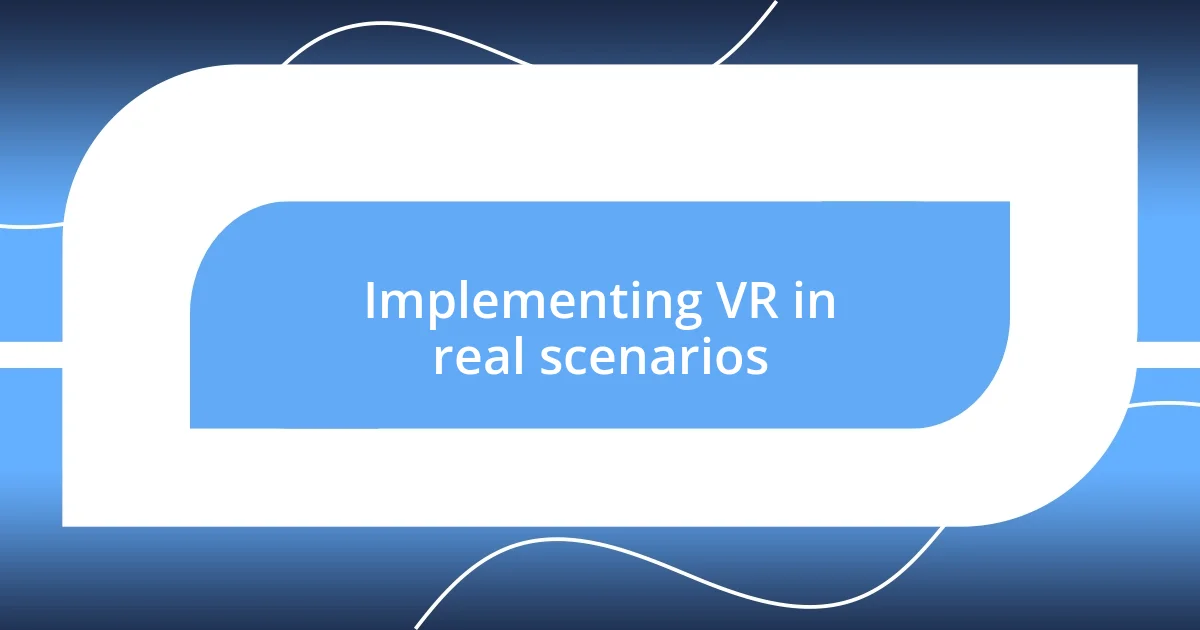Key takeaways:
- VR training enhances learning retention by providing immersive, hands-on experiences and allowing safe failure without real-world consequences.
- Effective VR training programs require real-life scenarios, targeted objectives, and robust feedback mechanisms to improve engagement and learning outcomes.
- Future trends in VR training include personalized learning experiences and AI integration, offering potential for transformative, adaptable training solutions across various industries.

Understanding virtual reality training
Virtual reality training immerses individuals in lifelike environments, enabling them to practice skills in a controlled setting. I recall my first experience with VR training; the moment I put on the headset, I felt as if I were truly in a different world. Can you imagine how much more impactful training can be when it feels so real?
As I delved deeper into VR training, I realized its ability to enhance learning retention significantly. I remember a scenario where I had to navigate a complex machinery setup. The hands-on experience provided by VR was far more effective than traditional methods. It got me thinking—how often do we forget information learned through lectures alone?
Moreover, VR offers the unique advantage of safe failure, allowing learners to make mistakes without real-world consequences. I experienced this firsthand during a simulation where I mishandled a situation but could instantly restart. This freedom encourages exploration and builds confidence, crucial elements in any training process. Don’t you think it’s fascinating how technology can reshape our learning experiences?

Designing effective VR training programs
Designing an effective VR training program involves careful consideration of user engagement and interactivity. I often recommend incorporating real-life scenarios that challenge the trainee’s decision-making skills. For example, I once designed a program for emergency response training that simulated various crisis situations. Participants reported feeling a rush of adrenaline, which made the learning experience memorable and impactful.
Additionally, ensuring that the VR content is aligned with specific training objectives is crucial. I learned this the hard way during a project where our focus was too broad. By narrowing the objectives, we created a more cohesive training experience. I’ve seen firsthand how targeted content can lead to better outcomes—trainees not only grasp concepts faster but also apply them more effectively in real situations.
Finally, feedback mechanisms within the VR training system are essential for growth. In my experience, incorporating real-time performance analytics allows trainees to reflect on their actions immediately. When I implemented such a system, I noticed a significant improvement in participants’ ability to adjust their strategies based on the feedback provided. Don’t you think that having a dynamic learning environment makes all the difference?
| Key Features | Impact |
|---|---|
| Real-life scenarios | Enhances engagement and retention |
| Targeted objectives | Improves focus and effectiveness |
| Feedback mechanisms | Facilitates immediate improvement |

Selecting appropriate VR technology
Choosing the right VR technology is pivotal for a successful training program. I often find myself weighing various headsets, software, and platforms to match the specific needs of the training objectives. For instance, I once opted for a wireless VR headset for a training session focused on teamwork exercises; the freedom it provided led to a more dynamic and engaging experience. I can’t stress enough how important it is to select technology that not only meets the technical requirements but also enhances the training atmosphere.
Here are some key points to consider when selecting VR technology:
- User comfort and accessibility: Ensure that the headsets are comfortable for extended wear and easy to use for all trainees.
- Compatibility with software: Choose platforms that can easily integrate with the specific training programs you intend to use.
- Quality of graphics and interactivity: Higher quality visuals and immersive experiences tend to keep trainees engaged and boost learning retention.
The choices you make regarding VR technology can shape the very essence of the training experience, and I’ve learned that thoughtful deliberation in this area can lead to remarkable results. Each decision should be informed not just by specifications but by how those specifications align with the overall learning goals.

Implementing VR in real scenarios
Implementing virtual reality in real training scenarios can be transformative. I remember a project where we used VR to train retail employees on customer service techniques. By immersing them in virtual shopping environments, they experienced diverse interactions with customers, which made them much more adept at handling tricky situations in real life. Wouldn’t it make sense that practicing in a controlled yet realistic setting boosts confidence?
In another instance, we developed a VR program for medical professionals, simulating surgical procedures. It was fascinating to watch participants navigate through intricate processes while being immersed in the active environment of an operating room. The realism offered them a safe space to practice critical skills without the fear of real-world repercussions. Can you imagine how much more prepared a surgeon feels after facing virtual complications during training?
Moreover, integrating VR into leadership training has opened new avenues for understanding team dynamics. I once facilitated a session where trainees participated in a virtual crisis, prompting them to make pivotal decisions under pressure. The emotional engagement was palpable; many participants shared that they felt a sense of urgency and responsibility, which sparked valuable discussions about their leadership styles. How impactful do you think it is to grapple with real-time decisions in a virtual environment?

Evaluating training effectiveness with VR
Evaluating the effectiveness of VR training programs requires a nuanced approach. After every session, I make it a point to gather feedback from participants. Their insights often reveal aspects I might not have considered, such as the emotional impact of the VR experience. For example, during a debrief after a safety training simulation, one participant expressed that the emotional stakes made her more aware of real-life dangers. It’s these spontaneous revelations that guide my evaluation process.
I also like to track measurable outcomes. One time, I implemented a VR training module for conflict resolution and monitored performance metrics before and after. The surprising improvement in participants’ responses during live interactions highlighted the tangible benefits of the training. Isn’t it fascinating how immersing oneself in a virtual scenario can sharpen skills that are critical in the real world?
Another method I employ is iterative testing. After introducing a new VR scenario, I revisit the training sessions periodically, refining the content based on ongoing feedback and results. I recall a leadership training session where we adjusted the complexity of scenarios based on trainees’ comfort levels, ultimately enhancing engagement and learning retention. This adaptability in evaluation not only reflects my commitment to continuous improvement but also illustrates the dynamic nature of learning with VR technology.

Future trends in VR training
As I look ahead, one of the most exciting trends in VR training is the rise of personalized learning experiences. Imagine customizing a training program that adapts in real-time to the user’s performance. During a recent session, a colleague shared how he struggled with a specific technical task in a VR environment. By adjusting the scenario based on his performance, we created a unique learning pathway that not only boosted his skills but also significantly increased his confidence. Isn’t it incredible how tailored experiences can truly transform the learning journey?
Another aspect is the integration of artificial intelligence in VR training. I can envision a future where AI-driven avatars respond in real-time, enriching interactions during simulations. For instance, while developing a project for customer interaction, participants previously trained in VR faced an AI customer who adapted based on their responses. One trainee noted that handling the unpredictable nature of the AI made her feel better prepared for real-world interactions. What if we could always replicate that level of unpredictability in training?
Moreover, the potential for cross-industry application is immense. I remember attending a seminar where individuals from diverse fields — healthcare, aviation, and retail — shared their VR initiatives. The common thread was the belief that the immersive nature of VR fosters empathy and understanding across disciplines. Wouldn’t it be fascinating to see how insights from one industry could enhance training practices in another? The possibilities are not just exciting; they’re revolutionary for how we approach skill development in the future.














